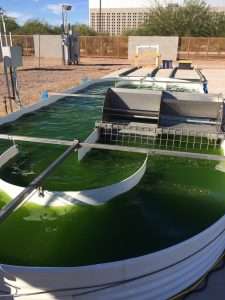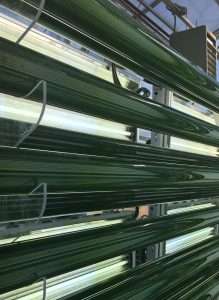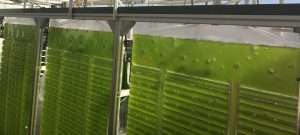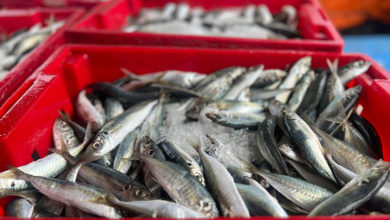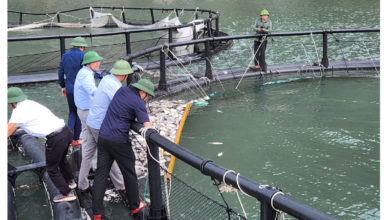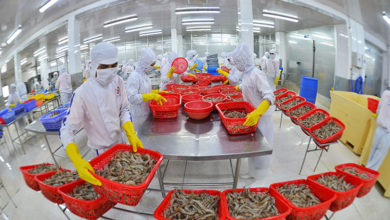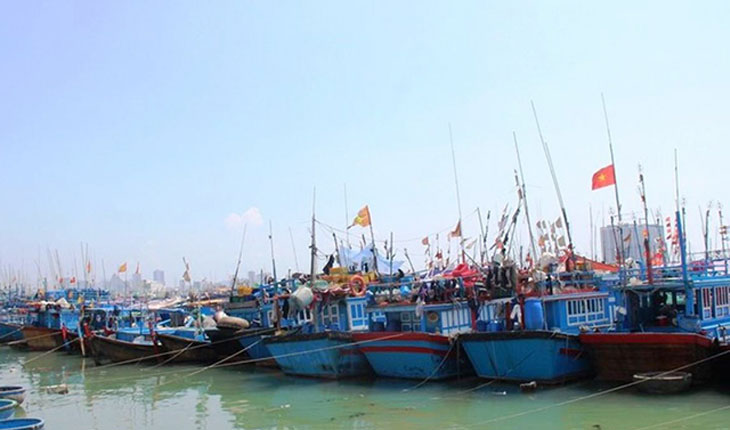What are open and closed algae culture systems?
The two broadest methods of culturing algae at medium to large scale are split into two styles of system: open and closed photobioreactors (PBRs). A PBR is any device or system that supports the culture of photosynthetic organisms using light. There are photobioreactor advantages and disadvantages to both types systems depending on the goals you have for culturing your algae.
In any type of algae production light penetration, light path and surface area to volume ratio all affect the density that can be achieved:
- The further light can penetrate into a culture, the more algal cells can be sufficiently lit to divide and grow, but as cell density increases, light is absorbed over a shorter distance within the culture.
- A shorter light path through cultures is beneficial to density as it allows light to reach a larger proportion of the culture, before being absorbed by the algae.
- Higher surface area to volume ratio is beneficial for the same reason.
All these factors have critical implications for the design of any system and shape how open and closed systems are used. In general open systems tend towards larger volumes, with lower density and closed systems tend toward higher densities with lower volumes.
OPEN ALGAE CULTURE SYSTEMS
By definition these systems are open and expose the algae culture in them to the “outside world”. Open culture systems tend to be lower cost than closed, but they have minimal control over the culture environment (temperature, light, pH, etc.), culture algae at lower densities than closed system (requiring more space to be economical), and are more prone to contamination.
Ambient air, rain, ocean spray, staff, and even wild animals can all be vectors for contaminants in open systems. Common contaminants like algal predators (zooplankton), bacteria, and competing strains can all reduce production efficiency or even spoil cultures. This leads most open culture systems to being operated in-batch. This is where algae is grown over a short period (3-7 days) where it can still out-compete the inherent contaminants until it is harvested completely.
Raceways ponds, fiberglass tanks, artificial ponds are all examples of open cultures. Being generally larger and simpler systems, they tend to be cheaper to set up proportionally to volume, however the densities achieved are often lower with higher levels of contaminants.
Raceway Ponds
Raceways ponds use short walls and paddle wheels to move a shallow pool of algae around a circuitous route. The culture depth is usually limited to about 1 ft (30 cm), so that the sun can illuminate it efficiently. They require large swaths of land because of their low water height, but can be very cost effective when operated well. Open raceway ponds saw widespread adoption during the algae-oil boom in the early 2000s. They are open systems and prone to contamination, so whatever you’re doing downstream with the algae needs to be tolerant to contamination, not to mention due to their large volume they require large volumes of inoculum.
Fiberglass Tanks
Fiberglass tanks (kawall tubes) are usually cylindrical and aerated from the bottom to create the mixing and gas exchange necessary for algae cultures. By using clear fiberglass the sidewalls in addition to the top surface can be illuminated for photosynthesis. They tend to be taller than they are wide, but most are much deeper than raceway ponds and have worse surface area to volume ratios due to increased water height, so their density is limited.
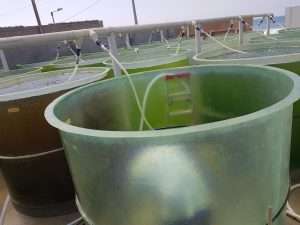
Sizes can range from tens of liters to tens of thousands. Due to the low cost of materials and their simplicity, open fibreglass tank culture are widely used in aquaculture, particularly in regions where labour is cheap, as these tanks need to be filled, inoculated, emptied and cleaned regularly.
If they are well managed and inoculated with a good inoculum culture, batch production in fiberglass tanks can provide lots of algae, albeit with a fair bit of effort and space.
Artificial Ponds
Artificial ponds are very similar to the fiberglass tanks, but are made with opaque side walls. This allows for even cheaper construction, but limits the illuminated surface area, because of this they tend toward squatter tanks. They can be made of pond liners, concrete, or simply with a hole in the ground. They are very labour intensive and require lots of cleaning to operate properly.
Overall open algae culture systems run for shorter periods as they cannot be run continuously; however, when expertly operated they can be very cost effective solutions for algae production at large scale.
CLOSED ALGAE CULTURE SYSTEMS
In a frustule (sorry – diatom pun), closed algae systems are ones where inputs are controlled and algae is grown in an enclosed environment. There are many varieties of closed photobioreactors (PBR). Many of the vital parameters important to algae can only be controlled in closed systems. Closed PBRs can use artificial or natural light and are generally more expensive initially than open systems, but being closed, they can operate at varying levels continuously.
A few examples of closed systems are tubular PBRs, single-use bag PBRs, flat panel PBRs, and Internally Lit Photobioreactors.
In a frustule (sorry – diatom pun), closed algae systems are ones where inputs are controlled and algae is grown in an enclosed environment. There are many varieties of closed photobioreactors (PBR). Many of the vital parameters important to algae can only be controlled in closed systems. Closed PBRs can use artificial or natural light and are generally more expensive initially than open systems, but being closed, they can operate at varying levels continuously.
A few examples of closed systems are tubular PBRs, single-use bag PBRs, flat panel PBRs
Tubular Photobioreactors
Tubular photobioreactors are made of a series of narrow diameter (2-4 in) transparent tubes connected to a reservoir and a pump that circulates the media (nutrients and water) and algae. They are most cost effectively lit with natural sunlight, but can also use artificial lighting when natural light is limiting. Because the light path is so short, they can achieve high-density cultures. Because of this they have become very popular for mass algae cultivation in the nutraceutical and biotech sectors where bioproducts from algae need to be dewatered and the product needs to be pure for the end application.
These systems can span acres and have an incredibly high surface area to volume ratio, which makes for a lot of area to clean. They utilize pigging (conceptually pumping a scrub brush through a pipe) to remove biofilm from the tubing, and large volumes of chemicals for cleaning between cultures. They have limited temperature control unless installed in a temperature controlled building or equipped with coolant jackets.
Single use bags
Plastic Bag Photobioreactors are usually cheaper than the other closed systems in upfront capital cost. There is no integrated temperature control, so they are also limited to where they can operate. The bags generally come gamma irradiated or clean just by virtue of how the bag is manufactured. This allows for a clean environment to culture algae in; however the media entering must be properly treated otherwise the culture will quickly contaminate and when bags become contaminated, the bags need to be thrown away. Generally these systems rely on pasteurization which are very energy intensive. Generally bags are delicate and finicky systems that require skilled operators to tune and tweak them to get optimal production. Their densities are limited by their surface to volume ratio much like smaller fiberglass tubes, which leads to a high number of replicates meaning more floor space and labour.
Flatpanel Photobioreactors
These are generally constructed from either glass or transparent plastic that laminate a thin (~3 in) layer of media and algae that is aerated from the bottom. They have a very short light path like tubular bioreactors, and have more challenging surfaces to clean, due to the geometry of them.
Internally Lit Photobioreactors
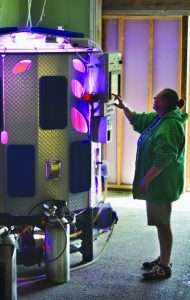 Internally lit PBRs are conceptually the opposite to tubular PBRs. Instead of putting small tubes of algae through lit areas, they put small intrusions of light though large algae volumes. They can have clear side walls or opaque, but most internally lit PBRs aerate the algae cultures. Because of the mixing and lit surface area to volume ratio, these PBRs are able to achieve densities 10-20 times greater than traditional bag or batch systems. And like tubular PBRs, the high surface area to volume ratio, creates lots of area for cleaning, which can be a nuisance unless equipped with an internal Clean-in-place (CIP) system.
Internally lit PBRs are conceptually the opposite to tubular PBRs. Instead of putting small tubes of algae through lit areas, they put small intrusions of light though large algae volumes. They can have clear side walls or opaque, but most internally lit PBRs aerate the algae cultures. Because of the mixing and lit surface area to volume ratio, these PBRs are able to achieve densities 10-20 times greater than traditional bag or batch systems. And like tubular PBRs, the high surface area to volume ratio, creates lots of area for cleaning, which can be a nuisance unless equipped with an internal Clean-in-place (CIP) system.
Because of the central volume of algae these systems can make use of heat exchangers to automatically control the culture temperature. This allows for a wider range of acceptable ambient temperatures. Like other closed PBRs there is a higher capital investment, but with the high density continuous culture these PBRs pay back that capital investment labour savings, lowered operational cost and higher biosecurity. This leads to countless downstream benefits.
What to consider when assessing what is right for you
With this in mind, here are some starter questions to ask yourself when choosing a system right for your goals:
- How much algae am I looking to produce? Try to get a metric of dry weight or cells per day that you need to be successful. Keep in mind plans for expansion.
- How many algal strains do I need to produce?
- Is my strain hard to culture continuously consistently (ie. dinoflagellates, cyanobacteria, diatoms etc)
- Am I floor space limited and should I allocate more for culturing algae?
- Is continuous culture important?
- Can you easily find knowledgeable, skilled algae technicians where you’re located?
- Is biosecurity (uncontaminated algae) a key factor for success?
- Do you have consistent sunlight and stable temperature in your region (i.e. do you live in Hawaii). Or will you benefit from artificial lights and on board temperature control?
- Is the ease of automation leading to long term labour savings something you’d be willing to invest in?
- Have you considered the short term vs long term investment?
- Do you have the knowledge and skills to culture algae successfully or could you use support?
The algae experts at Industrial Plankton would love to discuss your objectives and help you find a solution to meet your needs. Let’s talk!
Email sales@industrialplankton.com or call +1-250-889-5075
Industrial Plankton


